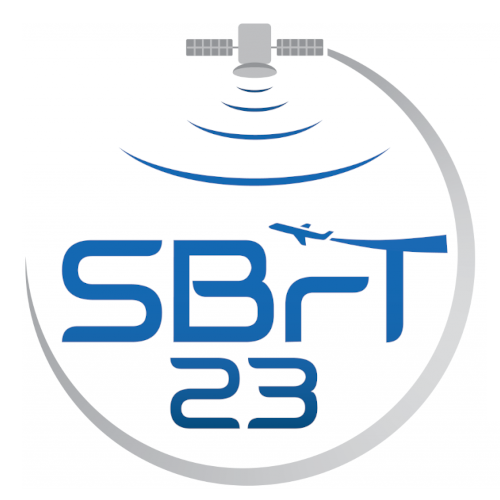
XLI Simpósio Brasileiro de Telecomunicações e Processamento de Sinais
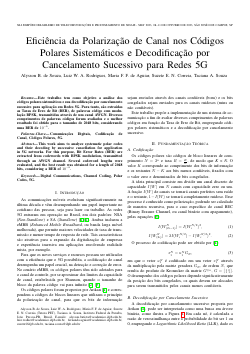
Eficiência da Polarização de Canal nos Códigos Polares Sistemáticos e Decodificação por Cancelamento Sucessivo para Redes 5G
Alysson Souza, Luiz Rodrigues, Maria Aguiar, Suzete Correia, Taciana Souza
DOI: 10.14209/sbrt.2023.1570923777
Keywords: Comunicações Digitais Codificação de Canal Códigos Polares 5G
Abstract
Este trabalho tem como objetivo a análise dos códigos polares sistemáticos e sua decodificação por cancelamento sucessivo para aplicação em Redes 5G. Para tanto, são extraídas as Taxas de Erro de Bit (BER), de palavras código com modulação BPSK, transmitidas através de um canal AWGN. Diversos comprimentos de palavras códigos foram avaliados e, o melhor resultado foi obtido para o tamanho de 2048 bits, considerando uma BER de 10−6.Download
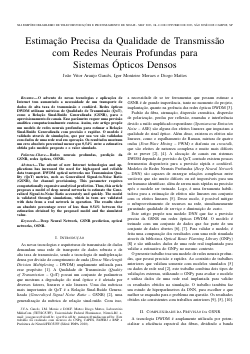
Estimação Precisa da Qualidade de Transmissão com Redes Neurais Profundas para Sistemas Ópticos Densos
João Vitor A Garcês, Igor Monteiro Moraes, Diogo M. F. Mattos
DOI: 10.14209/sbrt.2023.1570923779
Keywords: Deep Neural Network GSNR prediction Optical Networks OSNR
Abstract
The advent of new Internet technologies and ap- plications has increased the need for high-speed and reliable data transport. DWDM optical networks use Transmission Qua- lity (QoT) metrics, such as Generalized Signal-to-Noise Ratio (GSNR), for channel provisioning. This parameter requires computationally expensive analytical prediction. Thus, this article proposes a model of deep neural networks to estimate the Gene- ralized Signal-to-Noise Ratio accurately and quickly. The model is validated through simulations, which in turn are validated with data from a real network in operation. The results show an absolute percentage error of less than 0.54% between the estimation obtained by the proposed model and the simulated value.Download
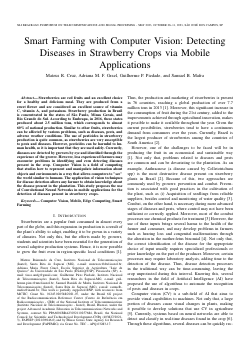
Smart Farming with Computer Vision: Detecting Diseases in Strawberry Crops via Mobile Applications
Mateus R Cruz, Guilherme Pires Pieadade, Adriana Maria Fuzer Grael, Samuel Mafra
DOI: 10.14209/sbrt.2023.1570923797
Keywords: Computer Vision Mobile Edge Computing Smart Farming
Abstract
Strawberries are red fruits and an excellent choice for a healthy and delicious meal. They are produced from a sweet flower and are considered an excellent source of vitamin C, vitamin A, and potassium. Strawberry production in Brazil is concentrated in the states of São Paulo, Minas Gerais, and Rio Grande do Sul. According to Embrapa, in 2016, these states produced about 2.5 million tons, which corresponds to almost 60\% of national production. Similar to other fruits, strawberries can be affected by various problems, such as diseases, pests, and adverse weather conditions. The use of pesticides in strawberry production is quite common, as strawberries are very susceptible to pests and diseases. However, pesticides can be harmful to human health, so it is important that they are used safely. Currently, diseases are detected by growers by eye and identified through the experience of the grower. However, less experienced farmers may encounter problems in identifying and even detecting diseases present in the crop. Computer Vision is a field of computing that studies how to represent and manipulate information about objects and environments in a way that allows computers to "see" the world similar to humans. The application of vision techniques for disease detection allows any farmer to obtain knowledge about the disease present in the plantation. This study proposes the use of Convolutional Neural Networks in mobile applications for the detection of diseases present in strawberry crops.Download
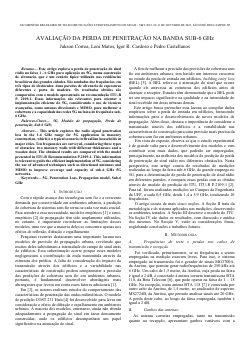
AVALIAÇÃO DA PERDA DE PENETRAÇÃO NA BANDA SUB-6 GHz
Jakson Matos Correa, Leni Matos, Igor Cardoso, Pedro Gonzalez Castellanos
DOI: 10.14209/sbrt.2023.1570923799
Keywords: 5G Modelo de propagação Perda de penetração Sub 6 GHz
Abstract
This article explores the radio signal penetration loss in the 1-6 GHz range for 5G application in masonry construction, which is a typical scenario in Brazilian households in major cities. Ten frequencies are surveyed, considering three types of obstacles: two masonry walls with different thicknesses and a wooden door. The obtained results are compared with the model presented in ITU-R Recommendation P.2109-1. This information is relevant to guide the efficient implementation of 5G, considering the use of advanced techniques such as directional antennas and MIMO to improve coverage and capacity of sub-6 GHz 5G networks.Download
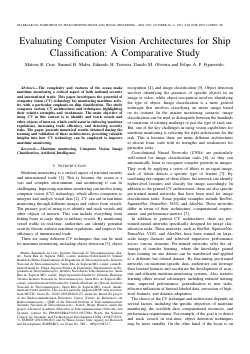
Evaluating Computer Vision Architectures for Ship Classification: A Comparative Study
Mateus R Cruz, Felipe Augusto Pereira de Figueiredo, Samuel Mafra, Danilo Machado de Oliveira, Eduardo Henrique Teixeira
DOI: 10.14209/sbrt.2023.1570923801
Keywords:
Abstract
The complexity and vastness of the ocean make maritime monitoring a critical aspect of both national security and international trade. This paper investigates the potential of computer vision (CV) technology for monitoring maritime activity, with a particular emphasis on ship classification. The study compares various CV architectures and techniques, highlighting their relative strengths and weaknesses. The main objective of using CV in this context is to identify and track vessels and other objects of interest, which could assist in enforcing maritime regulations, increasing trade efficiency, and detecting security risks. The paper presents numerical results obtained during the training and validation of these architectures, providing valuable insights into how CV technology can be employed to improve maritime monitoring.Download
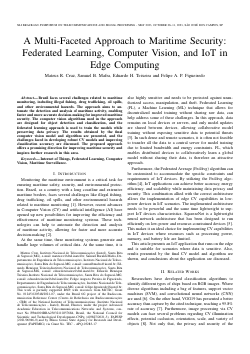
A Multi-Faceted Approach to Maritime Security: Federated Learning, Computer Vision, and IoT in Edge Computing
Mateus R Cruz, Eduardo Henrique Teixeira, Samuel Mafra, Felipe Augusto Pereira de Figueiredo
DOI: 10.14209/sbrt.2023.1570923804
Keywords:
Abstract
Brazil faces several challenges related to maritime monitoring, including illegal fishing, drug trafficking, oil spills, and other environmental hazards. Recent advances in Computer Vision and artificial intelligence (AI) offer new possibilities for improving the efficiency and effectiveness of maritime monitoring systems. This paper proposes a multi-faceted approach that combines federated learning, computer vision, and IoT in edge computing to automate the detection and analysis of maritime activity. The proposed approach can enable faster and more accurate decision-making for improved maritime security.Download
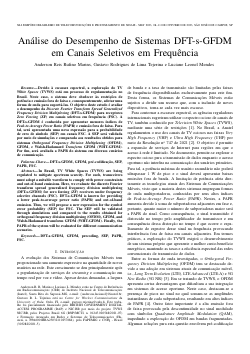
Análise do Desempenho de Sistemas DFT-s-GFDM em Canais FSC
Anderson Reis Rufino Marins, Gustavo Rodrigues de Lima Tejerina, Luciano Leonel Mendes
DOI: 10.14209/sbrt.2023.1570923805
Keywords: DFT-s-GFDM precoding SEP PAPR
Abstract
In Brazil, TV White Spaces (TVWS) are being regulated to mitigate spectrum scarcity. For such, transceivers must adopt a suitable waveform to comply with power constraints and out-of-band emissions. Here, we evaluate the discrete Fourier transform spread generalized frequency division multiplexing (DFT-s-GFDM) for zero forcing (ZF) receivers under frequency selective channels (FSC). DFT-s-GFDM is known for providing a lower peak-to-average power ratio (PAPR) and out-of-band emission. Thus, we will propose a new expression for the symbol error probability (SEP) for FSC. The SEP will be validated through simulations and compared to the results obtained for orthogonal frequency division multiplexing (OFDM), GFDM, and Walsh-Hadamard transform GFDM (WHT-GFDM). Finally, the PAPR of the system will be evaluated for different communication scenarios.Download
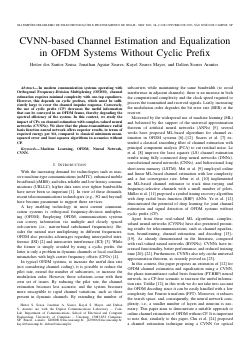
CVNN-based Channel Estimation and Equalization in OFDM Systems Without Cyclic Prefix
Heitor dos Santos Sousa, Jonathan Aguiar Soares, Kayol S. Mayer, Dalton Arantes
DOI: 10.14209/sbrt.2023.1570923809
Keywords: Machine Learning OFDM Neural Network CVNN
Abstract
In modern communication systems operating with Orthogonal Frequency-Division Multiplexing (OFDM), channel estimation requires minimal complexity with one-tap equalizers. However, this depends on cyclic prefixes, which must be sufficiently large to cover the channel impulse response. Conversely, the use of cyclic prefix (CP) decreases the useful information that can be conveyed in an OFDM frame, thereby degrading the spectral efficiency of the system. In this context, we study the impact of CPs on channel estimation with complex-valued neural networks (CVNNs). We show that the phase-transmittance radial basis function neural network offers superior results, in terms of required energy per bit, compared to classical minimum mean-squared error and least squares algorithms in scenarios without CP.Download
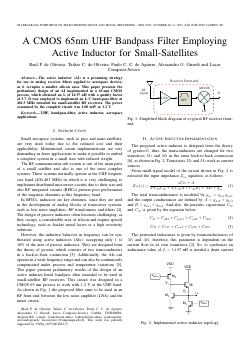
A CMOS 65nm UHF Bandpass Filter Employing Active Inductor for Small-Satellites
Raul Pedrotti de Oliveira, Tailize Cordeiro de Oliveira, Paulo de Aguirre, Alessandro Girardi, Lucas Severo
DOI: 10.14209/sbrt.2023.1570923815
Keywords: UHF bandpass-filter active inductor aerospace applications
Abstract
The active inductor (AI) is a promising strategy for use in analog receiver filters applied to aerospace devices, as it occupies a smaller silicon area. This paper presents the preliminary design of an AI implemented in a 65-nm CMOS process, which obtained an L of 14.97~nH with a quality factor of 3.7. It was employed to implement an L-C band-pass filter at 401.5~MHz intended for small-satellite RF receivers.Download
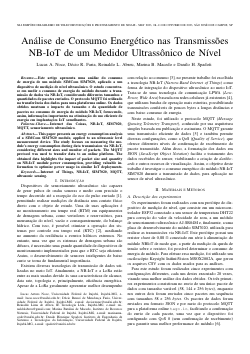
Análise de Consumo Energético nas Transmissões NB-IoT de um Medidor Ultrassônico de Nível
Lucas A Noce, Décio R Faria, Reinaldo Abreu, Marina B Macedo, Danilo Spadoti
DOI: 10.14209/sbrt.2023.1570923818
Keywords: Internet of Things NB-IoT SIM7020 MQTT
Abstract
This paper presents an energy consumption analysis of a SIMCom SIM7020 module, which is applied to an ultrasonic level measurement device. The study focuses on measuring the module's energy consumption during data transmission via NBIoT, considering different sizes and number of transmitted packets. The MQTT protocol was used to transfer data to an online platform. The obtained data highlights the impact of packet size and quantity on NB-IoT module power consumption, providing valuable information to optimize power usage in similar IoT deployments.Download